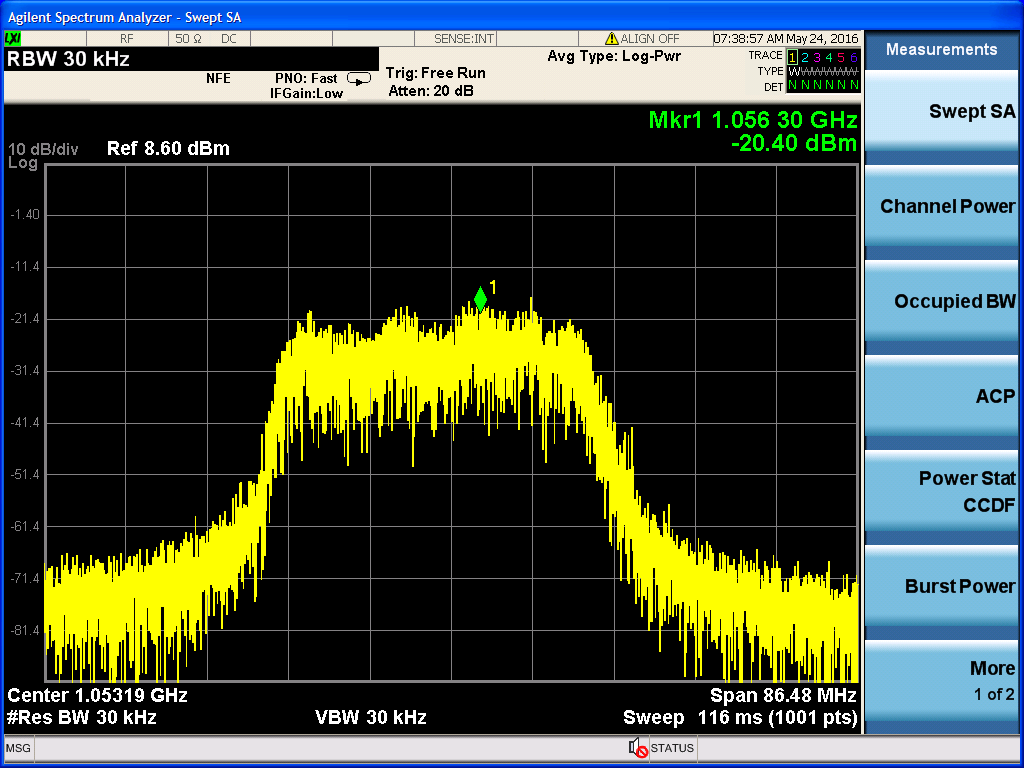Issue with the VCO testing (modulated output spectrum?)
I am trying to test a VCO chip. The output spectrum is not clean and seems to get modulated with a bandwidth of 20MHz (shown in the figure). Kvco is pretty high about 1.6GHz/V and it matches the simulation. Has anyone seen this before? Is it due to the reason that my supply is not clean or it is because of something else? It is my first time testing a chip so any suggestion will be highly appreciated!
Faye

Hi,
With this high Kvco, power supply noise of 125mV can cause 20MHz noise BW. However I would expect some spurious response and not "flat" response as shown on the figure. Are you testing free running VCO or PLL? If it is PLL than I observed tgis kind of response many times, when the PLL is not locked.
Supply your IC ( or whatever ) by a simple battery ( including Vtune Input if there is one ) and observe the VCO output.
1.6GHz/V is a huge KVCO and you will never prevent the poor and dirty VCO signal with this KVCO.It's not normal..
Yes this! And derive your tuning voltage with a 1 K potentiometer followed by a 10 uF ceramic capacitor. Finally, DUAL dc block your spectrum analyzer from the VCO/Battery combination with an inside/outside DC block. If it is an unpackaged chip, put a piece of cardboard over it so that the room light does not modulate it.
biff44, thank you so much for your suggestions.
Yes it is an unpackaged chip and I am probe testing it.
I was using a bias tee to dc block and ac couple the output signal. For the inside/outside DC block, can I just use two bias tees to block both signal and ground (since the signal comes out from an sma connector, i was guessing it is not that easy to do it?)? Or is there anything I could buy on the market?
Faye
Yes the Kvco is pretty huge since it is a delay-line ring oscillator. Thank you for your suggestions on using the battery. I will try it.
Faye
Hi Romansh, thank you for your reply.
It is a free running VCO. I also have a PLL with this VCO but havent tested it yet.
Faye
http://weinschel-catalog.apitech.com...-8-6-ghz/7012?
or you can take two waveguide pieces, place a thin sheet of plastic inbetween the two flanges, and use plastic screws to hole the flanges together.
The idea is that the spectrum analyzer has a LOT of 60 Hz hum on its supposed chassis "ground". When you hook that piece of equipment to something else, like a sensitive VCO with its own power supply as a tuning voltage....th power supply "ground" and the spectrum analyzer "ground" could easily have 100 mV of ac difference.
That is a good reason to NOT earth ground your power supply. The earth ground in the AC wall receptacle is NEVER at zero potential...it always has AC riding on it.
Hi Biff44,
Thanks so much for your information. I am still having some questions and hope that you can clarify.
1. "or you can take two waveguide pieces, place a thin sheet of plastic inbetween the two flanges, and use plastic screws to hole the flanges together. " Could you please provide more info or reference on this DC block solution? Does that mean that I may also need waveguide to coax adapters?
2. Now I am confused about the grounds. If I use the batteries as the power supply and the tuning supply, and I want to measure the output with spectrum analyzer, do I need to connect the SA ground to my battery ground? If not, the SA ground is the earth ground, and the battery ground is a different one, will that bring any problems in the measurement?
Many thanks,
Faye
I've tried to power, tune and bias the VCO with AA batteries, and it worked! The output spectrum is not modulated anymore. Thank you guys for your help!
